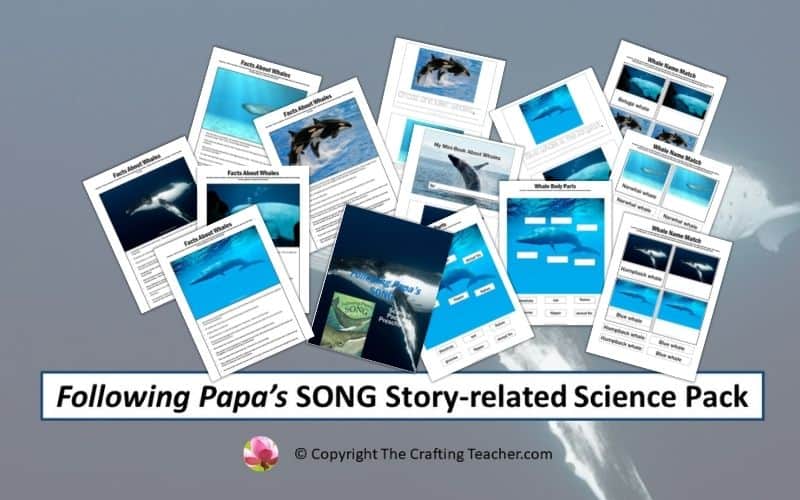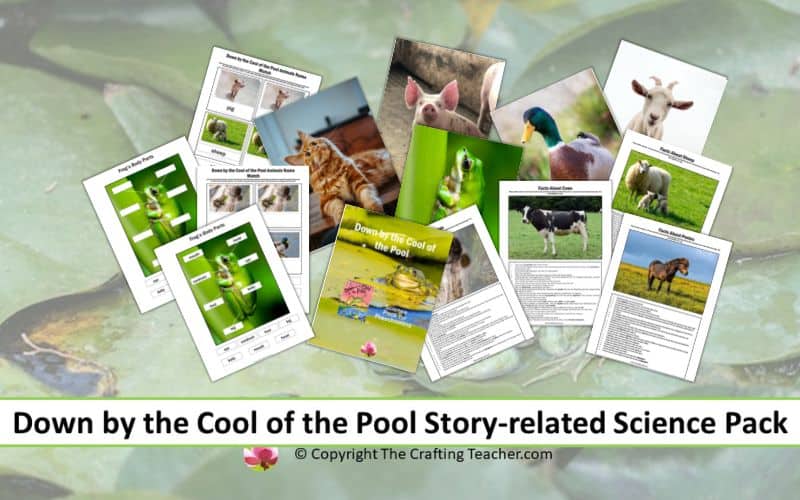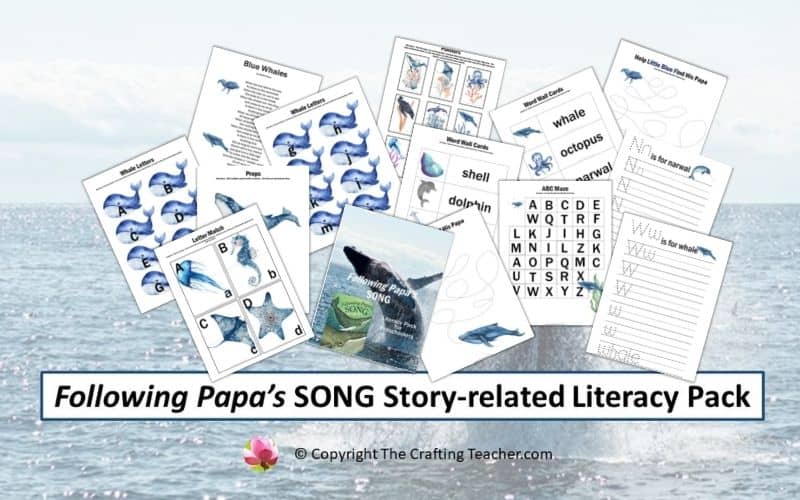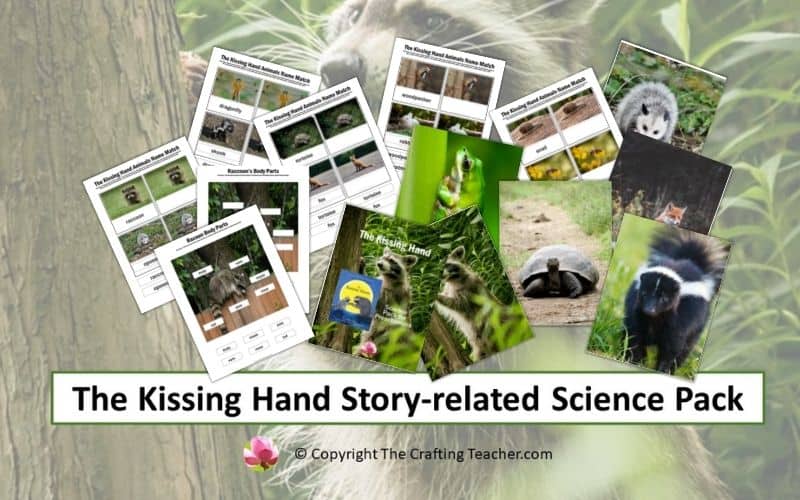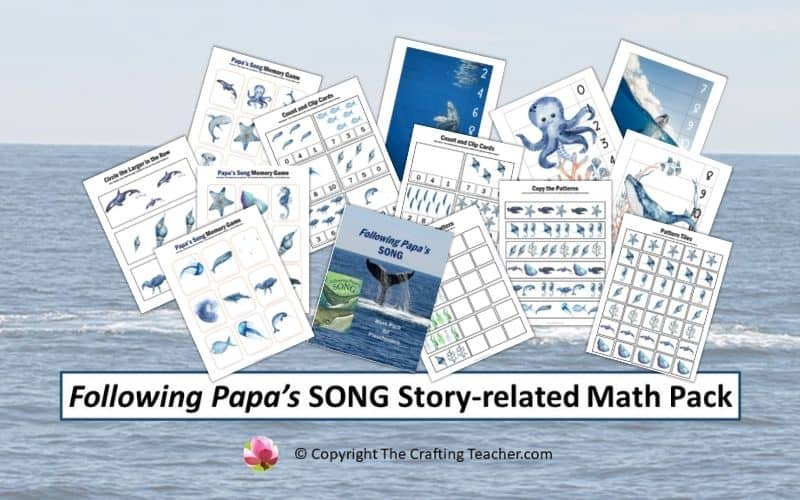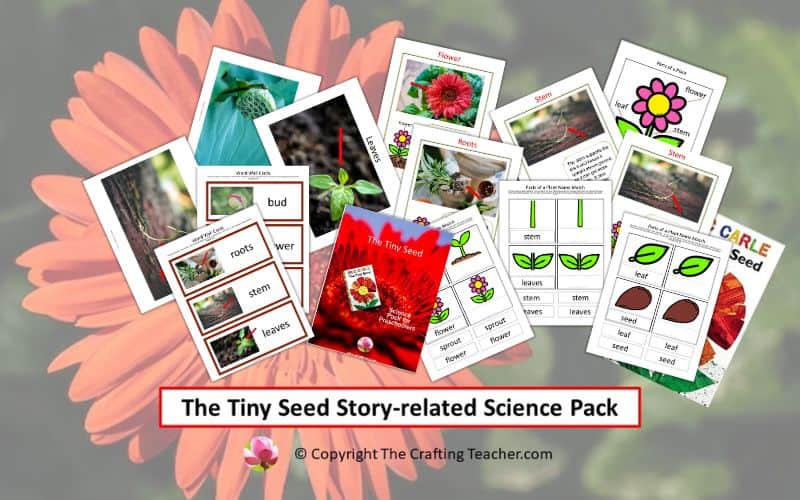Following Papa’s SONG Story-related Science Pack For Preschoolers
Affiliate Disclosure: “This post contains affiliate links, which means I receive a small commission, at no extra cost to you, if you make a purchase using those links.”
Storybooks are a wonderful source for Science activities, and Following Papa’s SONG is no exception. Children find the world around them fascinating, and one of the things that makes them more curious is whales. This book is a story about two humpback whales, father and son, and a perfect opportunity for a Science lesson. This Following Papa’s SONG Story-related Science Pack will help you introduce these beautiful mammals to your preschoolers. But, before we get to that, let’s talk a little bit about how to introduce Science to Preschoolers.
Introducing Science to Preschoolers
Many teachers feel intimidated when they have to teach Science to their preschoolers, but they shouldn’t be. Preschoolers are naturally curious about their world, so it’s very easy and a great idea to get them to engage in science activities at an early age. The secret is to do hands-on experiments with them, answer their questions, and let them explore and experiment.
You can start by telling your preschoolers that Science is the study of the world around us, and the part of Science that studies animals, in this case whales, is called Zoology. It is also possible to integrate all the other domains using science. You can read more about it in this post.
Benefits of Teaching Science to Preschoolers
Curiosity is as natural in young children as breathing. They are always trying to make sense of what they perceive with their senses, ask tons of questions to find the “why” about things, and they are always investigating to find out how things work. We must take advantage of their natural curiosity and help them develop their scientific thinking.
Taking your time to introduce science to young children in a fun and interactive way, gives them many benefits. Some of them are:
- Use their interest in exploring and experimenting to establish a positive connection to science and encourage them to love it and stay interested for many years, if not thorough their entire life.
- Stimulate their scientific thinking helping them make sense of the world around them, and understand why things happened and how they work.
- Extend their vocabulary promoting the development of language using scientific words, their communication, teamwork and cooperation, reasoning, and problem-solving skills. You can use science to teach every domain because it can easily tie up to literacy, math, and art. Therefore, always encourage your children to ask questions, observe different types of natural phenomena, experiment, and explore, but, most importantly, give them plenty of opportunities to do just that by offering fun, interactive, and hands-on experiences.
Following Papa’s SONG Science Pack
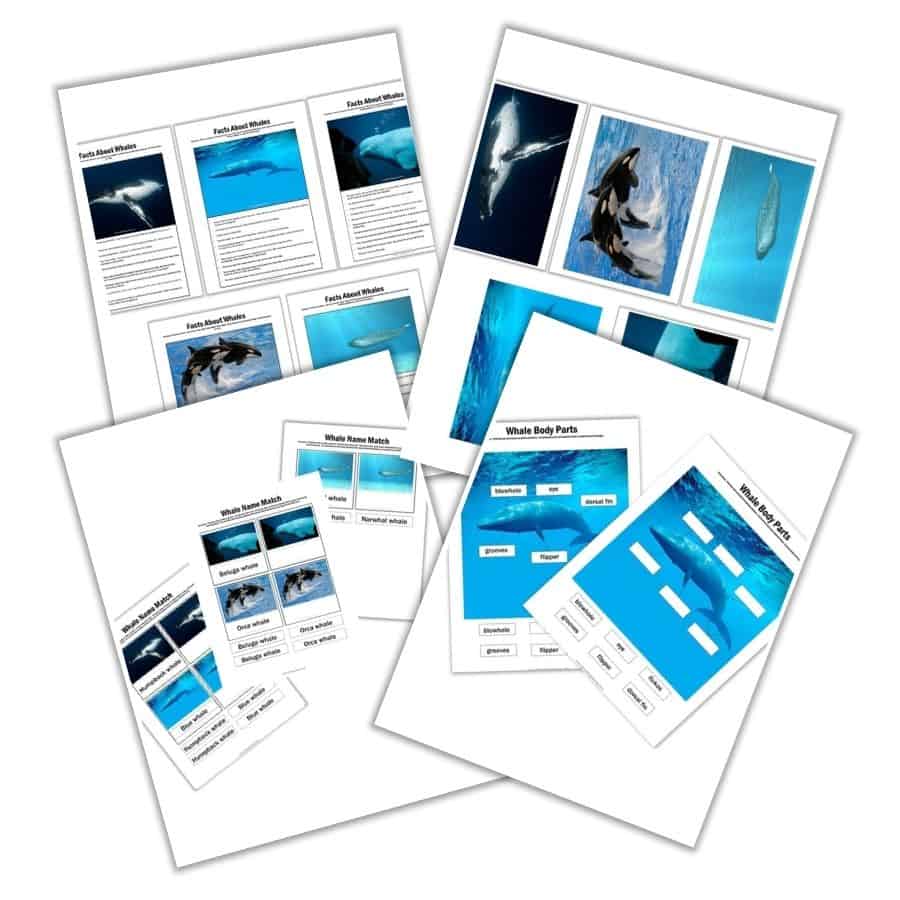
This FREE Following Papa’s SONG Story-related Science Pack is 12 pages long and includes several fun and educational science activities related to the story. You can download it at the end of this post.
Following Papa’s SONG is a heartwarming story filled with the wonders of the ocean and the comfort of a father’s presence, and there are many science activities you can do using this storybook as a base. I’m sure you can come up with many, but I wanted to give you some of the activities I like to use.
Explain What is a Whale and Some Important Facts.
Show them toy whales and/or real pictures of those whales. Ask them what they see and create a KWL chart (K = what they know; W = what they want to know and L = what they learn).
Write down everything they know about the whales in the K column and everything they want to know under the W column. At the end of the theme, when you review what they learned about whales, write down the information in the L column). Keep it up to allow them to come back to it, discuss the information, and ask questions about it.
Top Whale Facts for Kids
Below are some general facts about whales, easy for preschoolers to understand.
1. Whales are mammals. This means that whale calves grow inside their mothers until they are born. Besides, they are nursed and taken care of by their mothers until they reach a certain age.
2. Whales breathe air as we do. Therefore, they need to reach the surface of the ocean to breathe because they cannot breathe underwater.
3. To breathe, whales have a blowhole at the top of their heads. When they reach the surface, they take air in through this blowhole.
4. There are two types of whales, Baleen Whales, and Toothed Whales. There are several species of whales out there, but they are classified according to the way they feed in two types, baleen whales and toothed whales.
5. Baleen whales feed from krill and plankton. Krill are shrimp-like creatures which are very important ocean creatures.
6. Toothed whales eat several kinds of fish, like tuna, cod, and salmon among others, and some small mammals like seals.
7. The Blue whale is the largest animal in the world. Even more, it is the largest animal that has ever existed, even larger than the largest dinosaur ever found. The blue whale is a baleen whale.
8. Some baleen whales sing. Particularly the blue whales and the humpback whales are well known for singing.
9. Whales can swim as fast as 30 miles per hour.
10. Some Whales can stay underwater for as long as 90 minutes. This applies mainly to the sperm whale which can stay underwater for as long as 90 minutes, although a typical dive for other species is around 35 minutes.
11. Whales do not sleep as we do. To rest, whales sleep only half brain so they remember to take air in, otherwise they would drown.
12. The most famous story about whales is Moby Dick. Moby Dick is a novel released in 1851 by Herman Melville.
Introduce Some Types of Whales
Present pictures of different types of whales, and invite your students to talk about the differences they see in the pictures. After they discuss the differences they see, tell them what type of whales they are looking at, and some facts about each of them.
The Following Papa’s SONG Science Pack includes five cards about Humpback, Blue, Beluga, Narwhal, and Orca whales with their pictures and the most relevant information. You can print them out on white cardstock, place the information part behind the picture, and laminate them. Then you can put them all together in a ring, to have them handy.
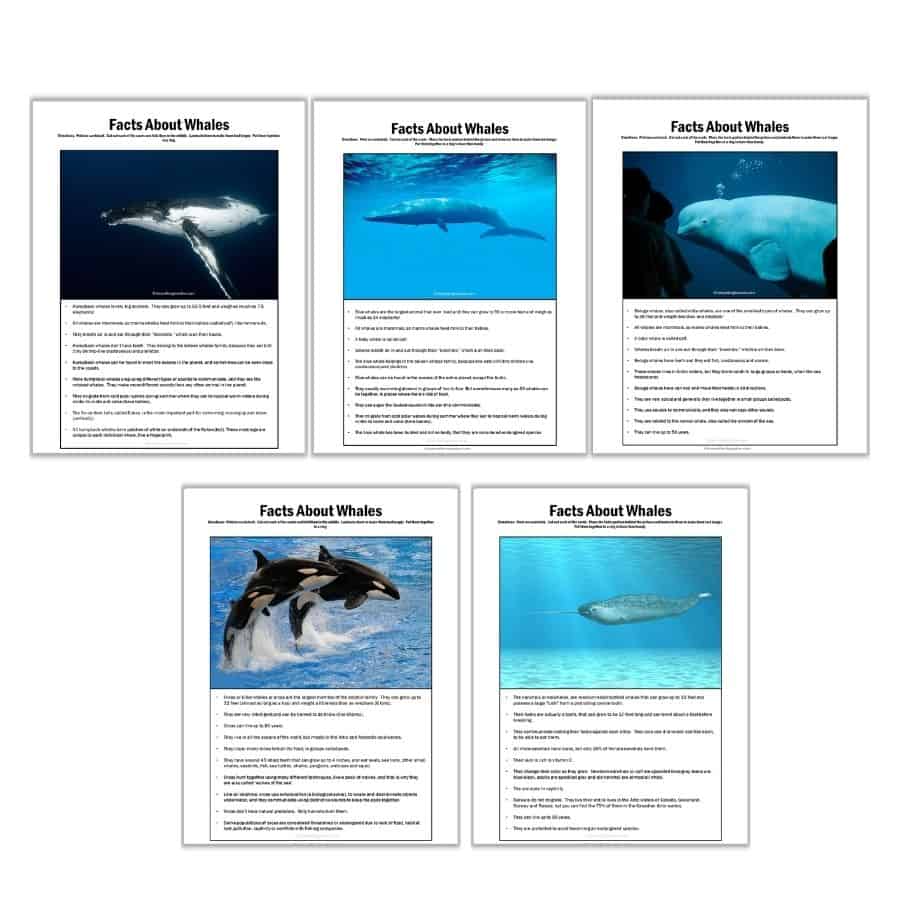
The Following Papa’s SONG Science Pack also includes five cards to match whales with their names in two versions, one with the name of the whale and another one blank, to give you choices according to your children’s level.
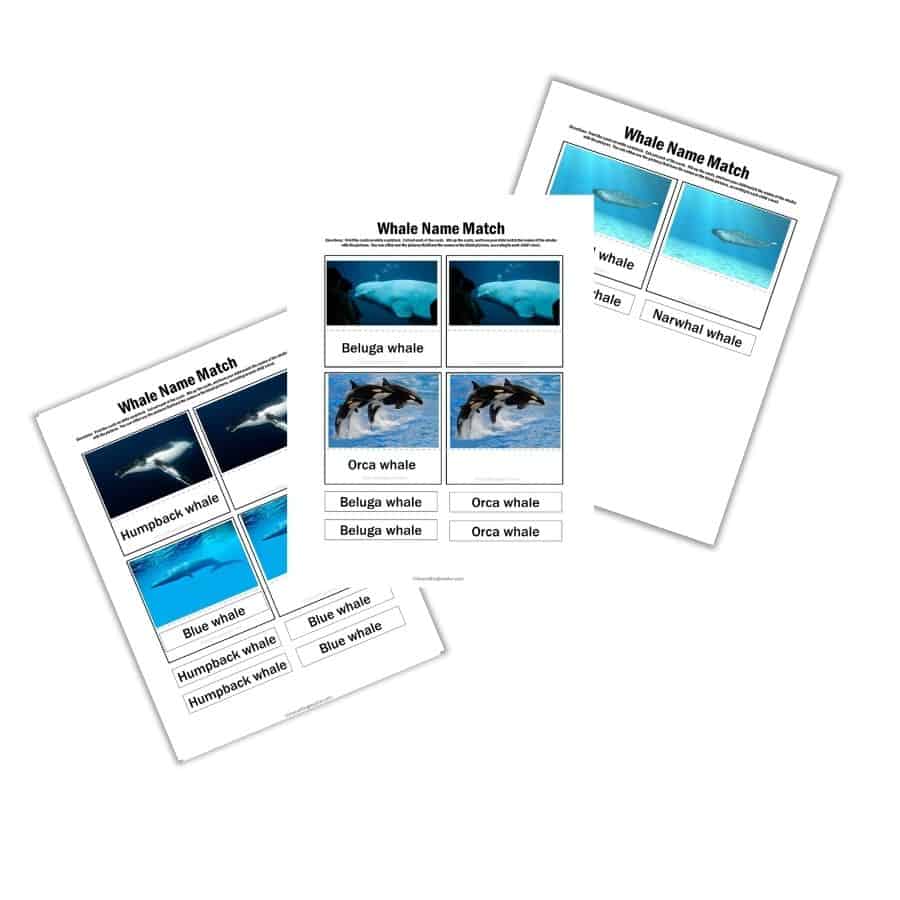
Investigate How Humpback Whales Eat Doing An Experiment
Explain to the children that humpback whales filter-feed on small crustaceans (mostly krill) and small fish, consuming up to 2,000 pounds of food per day. Humpback whales use several techniques to help them herd, corral, and disorient prey and that can include using bubbles, sounds, the seafloor, and even their pectoral fins.
To get this activity ready, you only need a handful of materials, which are:
- Ground Parsley and thyme
- large clear plastic bowl of water
- comb
Fill a large clear plastic bowl 2/3 full of water. Have a student sprinkle the parsley and thyme in the bowl (this will give them a wonderful sensory experience as well). Another student will run a comb across the surface of the water. Show the students how the comb collected the parsley and thyme on it. This will demonstrate how a whale eats krill by filtering them through its baleen.
Demonstrating Migration
Explain that Humpback whales in cold polar waters during summer to eat and then travel very far away during winter to tropical warm waters to mate and calve (have babies). This is called migration.
Have the children move from one end of the playground to the other end. Explain to them that they are migrating from one place to the next.
Comparing Some Whales’ Sizes
Explain that the Blue whale is the largest animal in the entire world, the Humpback whale is a middle-size whale and the narwhal is one of the smallest whales.
Have the children go to the playground. Select one volunteer for each type of whale. Have one child at a time count the steps to mark the size of each whale, with the help of the rest of the children, and stay in that place that marks the size of the whale he or she is representing.
- Blue whale – 90 feet long
- Humpback whale – 62.5 feet long
- Orca – 32 feet long
- Beluga – 20 feet long
- Narwal – 10 feet long
At the end of the activities, the children will see the size of each whale, according to the distance traveled by each volunteer.
Learning the Body Parts of a Whale
Print the picture of a whale in white cardstock and laminate it. Add tags with the name of its body parts previously printed in white cardstock and laminate them, using Velcro. Teach the children the names of their body parts and what are they for.
- Blowhole: The blowhole is the nose of the whale. It is located behind the bump on the top of the whale’s head.
- Eye: The eyes are located on each side of the body, near the base of the mouth. The whale can only see to the side, not directly in front of itself. A whale’s eye is very small for its size, roughly the size of a grapefruit.
- Throat grooves: This is like an excess skin that whales have on the throat, that expands and contracts to allow the whale to scoop up giant mouthfuls of food and water when it’s feeding.
- Flipper: The flipper is equivalent to the human hand and arm and is used for turning. Humpback whales have large flippers which they use to move through the ocean.
- Flukes: The tail flukes on a whale’s tail and are the most important part of swimming, moving up and down (vertically). All humpback whales have patches of white on the underside of the flukes (tail). These markings are unique to each whale, like a fingerprint.
- Dorsal fin: Dorsal means topside. The dorsal fin is believed to act as a keel to keep the whale oriented upright. The male killer whale has a dorsal fin six feet high. However, some whales (the gray and white whales) have no dorsal fin at all.
- Ear: The ear opening is a tiny hole located behind and slightly above the eye. Whales don’t hear sounds. They feel the vibrations of the sounds through their bodies to their inner ear.
- Mammary glands: the part of the whale’s body that produces milk for its baby (calf). They are located on the underside of the whale, close to the tail.
Children can practice matching the names of the body parts with the parts of the whale. In this particular mat, I excluded the ear and mammary glands since they are not noticeable in the picture, to make it easier for preschoolers and avoid a negative effect like frustration in your children.
The Following Papa’s SONG Science Pack two Whale Body Parts activities, to match the body parts, one with the name of the parts and another without words.
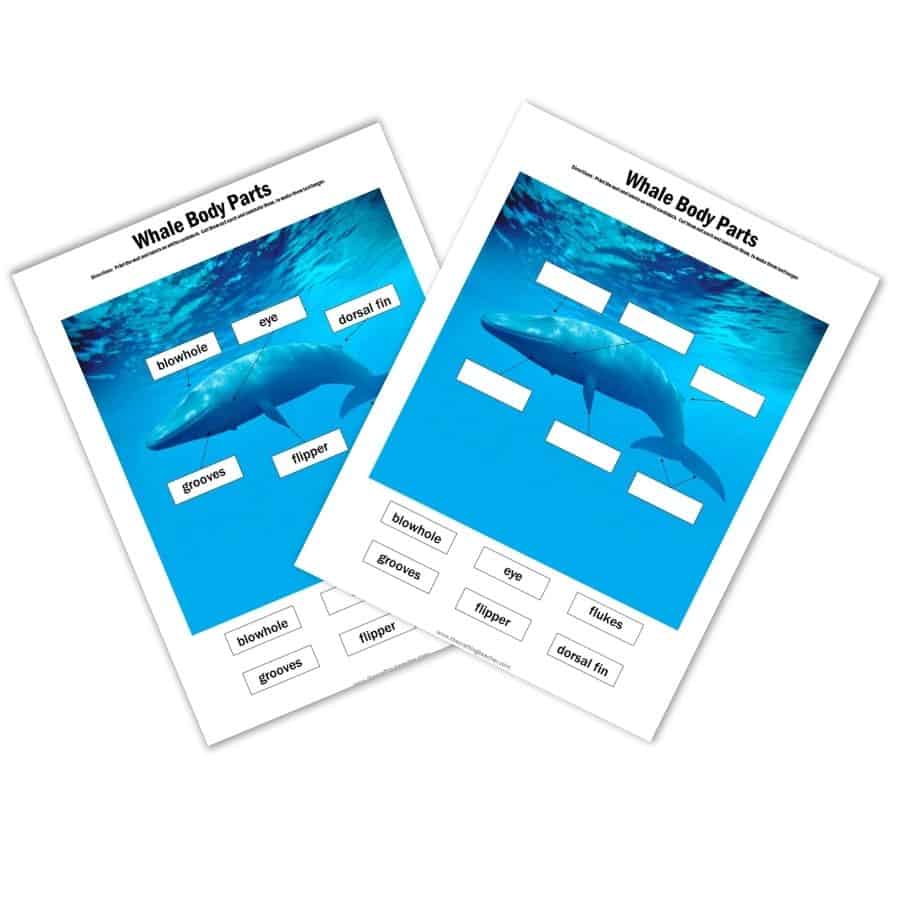
Facts About the Whales’ Song
Tell your students that whales use songs to communicate and socialize with each other, but only baleen whales sing. According to Current Biology, their songs can be characterized as clicks, whistles, and pulsed calls or compositions of “moans, snores, chirps, and cries”.
Show these interesting videos showing the humpback whale and the blue whale singing. After they finish watching the videos, start a discussion about what they saw.
Invite the children to pretend to be a whale and try to communicate with their friends using whale songs.
Songs, Fingerplays, and Rhymes
It is always best to tie other domains to the one you are purposely addressing, for a more complete learning process. Besides, kids love to sing and dance. Use this opportunity to introduce some literacy using songs, fingerplays, and rhymes. I found these on the Bethlehem Public Library website.
Blue Whales Poem
by Daniel Roure
When the sun falls to the sea
To shine on the mermaids
When the kids run out to see
The birds fly in the shade
When the whales turn blue
And weep as we all do
Is there in the world
Anything true
When we all forget the name
Of those stars in the sky
When all battles to gain fame
It is nothing but a lie
When the whales become so few
And weep as we all do
Is there in the world
Anything true
But as long as we’re live
There’s still a tiny chance
Just give love a little sign
To come into the dance
Give the whales a “Rendez-vous”
It’s all up to you
Apart from our dreams
There’s nothing true
When all four seasons are springs
With flowers in the air
When clouds carry on their wings
Good news from here and there
When the whales along the shore
Will tell us “how are you”…
Five Baby Whales Fingerplay
(Count down using your fingers)
Five baby whales dive to the ocean floor.
One swims away and then there are…
Four baby whales eat krill in the sea.
One swims away and then there are…
Three baby whales calling in the ocean blue.
One swims away and then there are…
Two baby whales breech in the sun.
One swims away and then there is…
One baby whale is lonely and alone.
She swims to find her friends and they all go home.
Whale Action Rhyme
A whale is not as small as us, (shake head and finger)
Most whales are bigger than a bus! (stretch arms out wide)
A whale is not a fish in the sea, (shake head and finger)
A whale breathes air like you and me. (take a deep breath)
A whale can’t walk on the ground, (shake head and finger)
A whale must swim to get around. (make a swimming motion)
A whale is a mammal like you and me, (nod head, point to self and kids)
But their home is in the deep blue sea. (make wave motion)
Books About Whales
As usual, I like to include books in all my activities. These are some of the most interesting books you can find. Below are some of my favorite books about whales. You can find them at your local library, used book store, and on Amazon. The titles have my affiliate links, that will take you directly to the right page on Amazon.
- Secrets of the Whales by Brian Skerry. In this provocative book of photography, we learn that whales share an amazing ability to learn and adapt to opportunities, from specialized feeding strategies to parenting techniques.
- Whales: An Illustrated Celebration by Kelsey Oseid. A gorgeously illustrated, entertaining, and educational guide explores the most interesting and illuminating facts about these marine mammals. It also covers the current state of wild and captive cetaceans worldwide, why we should care, and what we can do to help our beautiful marine mammal friends.
- Encyclopedia of Whales, Dolphins and Porpoises by Erich Hoyt. This book is a fascinating compilation of the latest data on cetaceans and an impassioned argument for the ongoing need for international protection of at-risk populations and their increasingly damaged habitat.
- The Big Book of the Blue by Yuval Zommer. The book opens by explaining how different types of animals can breathe and survive underwater, and the different families to which they belong.
- The Snail and the Whale by Julia Donaldson. This is the story of a tiny snail that meets a humpback whale and travels together to far-off lands. A very sweet story about an impossible friendship.
- National Geographic Readers: Whales by Jennifer Szymanski. This book includes simple text and large photos on every page. A vocabulary tree at the beginning of the book introduces kids to keywords in concept groups, helping kids make connections between words.
- Song for a Whale by Lynne Kelly. This is the story is about Iris, a deaf twelve-year-old tech genius. When she learns about Blue 55, a real whale who is unable to speak to other whales, Iris thinks about inventing a way to “sing” to him! Full of heart and poignancy, this affecting story shows how a little determination can make big waves.
- Whales: Amazing Pictures & Fun Facts on Animals in Nature by Kay de Silva. The book uses captivating illustrations, and carefully chosen words to teach children about the ‘gentle giants of the deep, giving a well-rounded understanding of these beautiful creatures: their anatomy, feeding habits, and behavior.
- National Geographic Readers: Great Migrations Whales by Laura Marsh. This book explains how sperm whales will easily travel the circumference of the Earth in search of food and the need to breed and find a mate.
- A Whale of a Tale!: All About Porpoises, Dolphins, and Whales by Bonnie Worth. While learning how cetaceans stay warm without hair, have teeth or baleen, swim in troops, spy hop, spin, breach, and see via echolocation, kids are introduced to almost 20 different species.
Pin It for Later
If you are in a rush and don’t have time to read the post and download the printable but want to save it for later, pin it to one of your Pinterest boards for later.
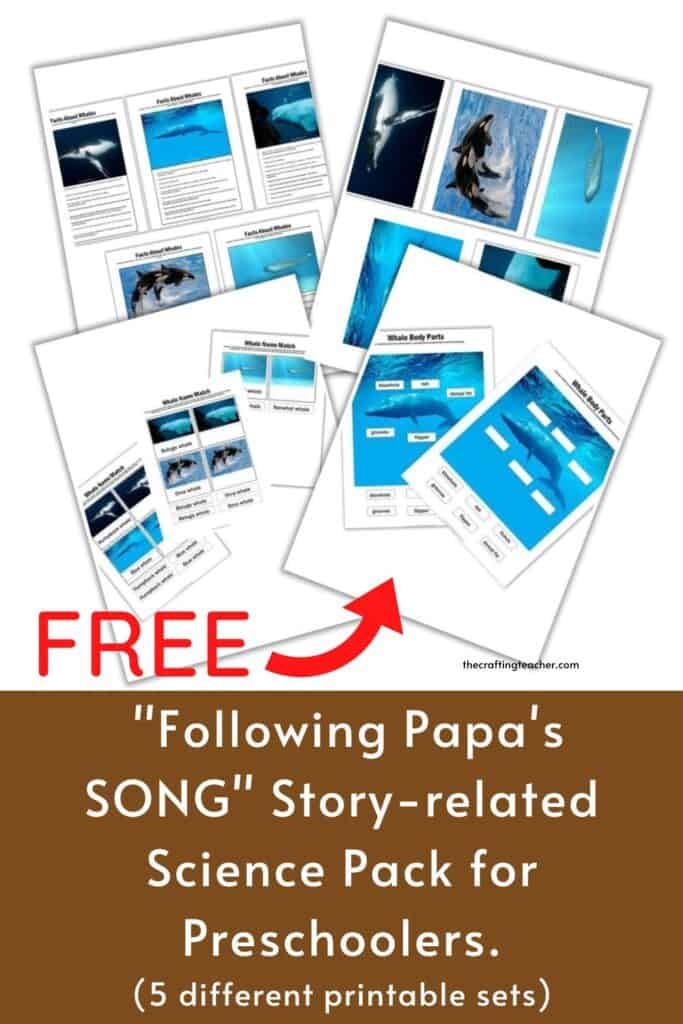
You can use these ideas by themselves, but I will invite you to combine them with the literacy and math activities I created for this beautiful story, Following Papa’s SONG, to take advantage of the opportunity this book offers. Remember that for a more comprehensive and complete educational process, you should not divorce literacy from math, science, or any other domain. They intermingle together and complement each other.
Don’t forget to download your FREE Following Papa’s SONG Science Pack. Just click the bottom below, and type your information, for an immediate download.
Be happy, safe, and creative. I wish you well.
Love,
P.D. Please let me know if you like any of these ideas that worked for you, or if you think I need to add or replace something. My goal is to help you in any way I can and I don’t like anything better than to post something that you might find useful. Also, if you come up with different ideas and want to share them, I would love to post them as well.

